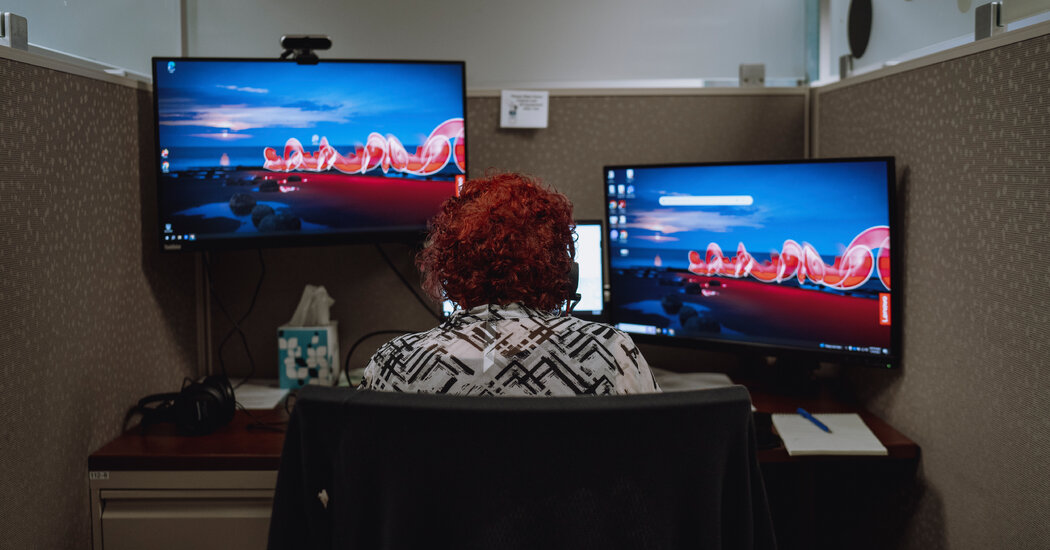One of the most important things reporters can do is trace how policies — laws and court decisions in particular — directly affect people across the United States.
That is why I spent a day at the National Domestic Violence Hotline in Austin, Texas, before two significant decisions from the Supreme Court: one about the availability of a commonly used abortion pill, and another about whether the government could prevent domestic abusers from owning firearms.
As a former congressional reporter who now covers the South for The New York Times, I’ve not only reported on gun policy, but also examined how it can intersect with domestic violence. In 2022, I helped report on the debate over the reauthorization of the Violence Against Women Act, which was enacted in 1994 and led to the creation of the hotline in 1996. That year I also covered the passage of gun safety legislation, which narrowed the so-called boyfriend loophole by strengthening a ban against the possession of firearms by domestic abusers.
For this article, it was important to center the voices of survivors of domestic violence — the people who are most likely to be affected by those Supreme Court decisions.
After interviews with experts and those who work at domestic violence shelters, what became clear was that the court’s rulings would directly affect what survivors experience, rather than combat root causes of the violence.
So my editors and I decided to tell the story through the work of the people who often connect with survivors first. We could show what a survivor’s initial communication to the hotline looked like, and share the perspectives of those working for the hotline itself, many of whom are survivors who escaped their abusers.
The hotline receives as many as 3,000 calls and messages a day. The data it had about changes in requests for help after crucial court rulings underscored the personal anecdotes about domestic violence we had been hearing. That included the decision in Dobbs v. Jackson Women’s Health Organization, which overturned Roe v. Wade in June 2022.
There were, understandably, safety concerns: The hotline can receive threats, so we had to keep its exact location anonymous and be careful with what to show in photographs.
We didn’t want to expose any of the people reaching out to the hotline, so we used only details that wouldn’t identify them. (Everything else, including the responses of the staff, was on the record.)
Everyone on the other end of the line was asking for help in a moment of vulnerability. My job was to observe; I didn’t want to take away from their conversations or insert myself in the interactions.
But it was also important to ensure that the person was able to consent to my presence. After several discussions with editors, a Times lawyer and people who work for the hotline, we settled on sharing a disclosure before each conversation. When a call or chat began, the hotline staff member first confirmed the person was safe and would remain anonymous. Then, the staff member told the caller or messenger that a Times reporter was on the line for an article about domestic violence. They were told they would not be identifiable in the article.
The person had the option to be transferred to another line — which some asked to be — or remain on the line with me as a silent observer.
This is why there are no male survivors quoted in my piece, even though domestic violence affects men. I didn’t listen to any conversations with a man that I could use in the article.
When I arrived in Texas and met with Isadora Kosofsky, the article’s photographer, I was anxious. These types of articles are always challenging, especially with limited time. You never know what you are going to see or hear or whether the interactions you happen to witness align with trends that experts have seen over weeks and months.
I observed exchanges for a few hours, but the hotline later provided a breakdown of the number of calls it received during the entire day.
I found myself holding my breath the first few times a caller or messenger was asked if she was comfortable remaining on the line with me there. Once I was cleared, I began keeping a log of the back and forth between the caller and the staff member, making sure to time-stamp each sentence. (The calls were not recorded.)
On a rolling chair, I scooted between two staff members at a time, leaning over a keyboard to read messages, or picking up headphones and listening to a conversation. I teared up repeatedly as callers spoke about the horrors they had experienced and hotline workers walked them through safety plans.
After a particularly tough call answered by Josie Slawik, we took a break, grabbing a piece of Hershey’s.
“There’s something about chocolate that works,” she told me.
This month, the court ruled on the abortion pill, upholding access. Then, on Friday, the day my article was published, the court ruled that the government could disarm those with restraining orders for domestic violence. That day, 1,881 people reached out to the hotline — and about 14.5 percent of those conversations mentioned a firearm.
I still think about the women I listened to, whose names I will never know. And I think about the people who are still answering their calls.
